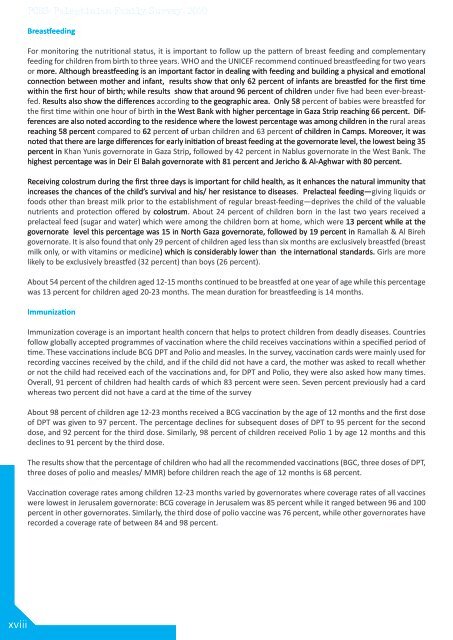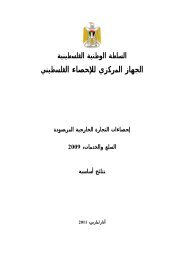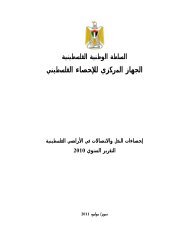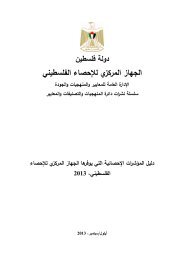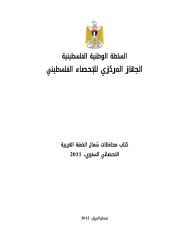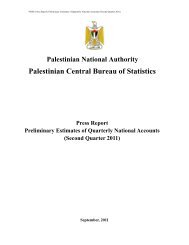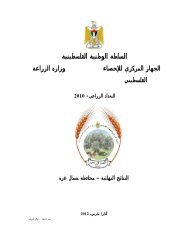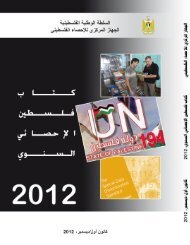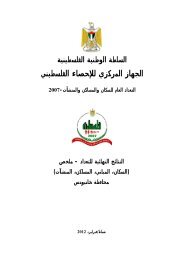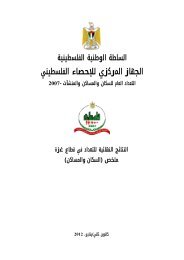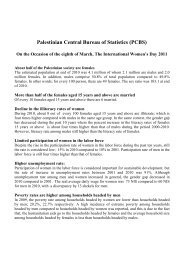Palestinian Family Survey 2010 Final Report - Palestinian Central ...
Palestinian Family Survey 2010 Final Report - Palestinian Central ...
Palestinian Family Survey 2010 Final Report - Palestinian Central ...
- No tags were found...
Create successful ePaper yourself
Turn your PDF publications into a flip-book with our unique Google optimized e-Paper software.
PCBS: <strong>Palestinian</strong> <strong>Family</strong> <strong>Survey</strong>, <strong>2010</strong>BreastfeedingFor monitoring the nutritional status, it is important to follow up the pattern of breast feeding and complementaryfeeding for children from birth to three years. WHO and the UNICEF recommend continued breastfeeding for two yearsor more. Although breastfeeding is an important factor in dealing with feeding and building a physical and emotionalconnection between mother and infant, results show that only 62 percent of infants are breastfed for the first timewithin the first hour of birth; while results show that around 96 percent of children under five had been ever-breastfed.Results also show the differences according to the geographic area. Only 58 percent of babies were breastfed forthe first time within one hour of birth in the West Bank with higher percentage in Gaza Strip reaching 66 percent. Differencesare also noted according to the residence where the lowest percentage was among children in the rural areasreaching 58 percent compared to 62 percent of urban children and 63 percent of children in Camps. Moreover, it wasnoted that there are large differences for early initiation of breast feeding at the governorate level, the lowest being 35percent in Khan Yunis governorate in Gaza Strip, followed by 42 percent in Nablus governorate in the West Bank. Thehighest percentage was in Deir El Balah governorate with 81 percent and Jericho & Al-Aghwar with 80 percent.Receiving colostrum during the first three days is important for child health, as it enhances the natural immunity thatincreases the chances of the child’s survival and his/ her resistance to diseases. Prelacteal feeding—giving liquids orfoods other than breast milk prior to the establishment of regular breast-feeding—deprives the child of the valuablenutrients and protection offered by colostrum. About 24 percent of children born in the last two years received aprelacteal feed (sugar and water) which were among the children born at home, which were 13 percent while at thegovernorate level this percentage was 15 in North Gaza governorate, followed by 19 percent in Ramallah & Al Birehgovernorate. It is also found that only 29 percent of children aged less than six months are exclusively breastfed (breastmilk only, or with vitamins or medicine) which is considerably lower than the international standards. Girls are morelikely to be exclusively breastfed (32 percent) than boys (26 percent).About 54 percent of the children aged 12-15 months continued to be breastfed at one year of age while this percentagewas 13 percent for children aged 20-23 months. The mean duration for breastfeeding is 14 months.ImmunizationImmunization coverage is an important health concern that helps to protect children from deadly diseases. Countriesfollow globally accepted programmes of vaccination where the child receives vaccinations within a specified period oftime. These vaccinations include BCG DPT and Polio and measles. In the survey, vaccination cards were mainly used forrecording vaccines received by the child, and if the child did not have a card, the mother was asked to recall whetheror not the child had received each of the vaccinations and, for DPT and Polio, they were also asked how many times.Overall, 91 percent of children had health cards of which 83 percent were seen. Seven percent previously had a cardwhereas two percent did not have a card at the time of the surveyAbout 98 percent of children age 12-23 months received a BCG vaccination by the age of 12 months and the first doseof DPT was given to 97 percent. The percentage declines for subsequent doses of DPT to 95 percent for the seconddose, and 92 percent for the third dose. Similarly, 98 percent of children received Polio 1 by age 12 months and thisdeclines to 91 percent by the third dose.The results show that the percentage of children who had all the recommended vaccinations (BGC, three doses of DPT,three doses of polio and measles/ MMR) before children reach the age of 12 months is 68 percent.Vaccination coverage rates among children 12-23 months varied by governorates where coverage rates of all vaccineswere lowest in Jerusalem governorate: BCG coverage in Jerusalem was 85 percent while it ranged between 96 and 100percent in other governorates. Similarly, the third dose of polio vaccine was 76 percent, while other governorates haverecorded a coverage rate of between 84 and 98 percent.xviii


